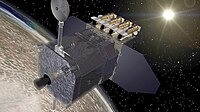
Photo from wikipedia
Shallow cumulus clouds exhibit highly three‐dimensional (3‐D) spatial structure leading to complex variability in the surface solar irradiance (SSI) beneath. This variability is captured by the typically bimodal shape of… Click to show full abstract
Shallow cumulus clouds exhibit highly three‐dimensional (3‐D) spatial structure leading to complex variability in the surface solar irradiance (SSI) beneath. This variability is captured by the typically bimodal shape of the SSI probability density function (PDF). Using large eddy simulation to generate well‐resolved cloud fields and Monte Carlo 3‐D radiative transfer to reproduce realistic associated SSI PDFs, we seek direct relationships between the cloud field properties and the SSI PDF shape. Applying both random forest and artificial neural network algorithms, we find variations in the two modes of the SSI PDF are well predicted by just a handful of cloud field properties. The two algorithms utilize cloud properties similarly, with indistinguishable performance despite their different architectures. These results offer a marked improvement in realism relative to one‐dimensional radiative transfer while bypassing computationally expensive 3‐D radiative transfer, with immediate application to renewable energy assessments, and potential for several other geophysical applications.
Journal Title: Geophysical Research Letters
Year Published: 2020
Link to full text (if available)
Share on Social Media: Sign Up to like & get
recommendations!